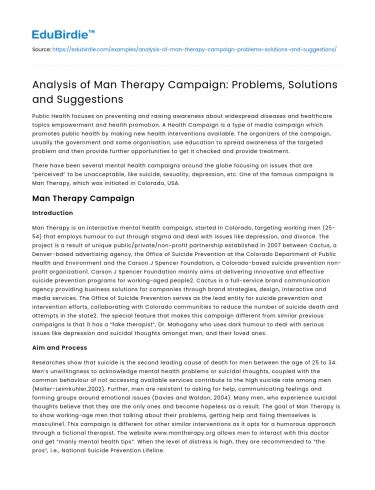Public Health focuses on preventing and raising awareness about widespread diseases and healthcare topics empowerment and health promotion. A Health Campaign is a type of media campaign which promotes public health by making new health interventions available. The organizers of the campaign, usually the government and some organisation, use education to spread awareness of the targeted problem and then provide further opportunities to get it checked and provide treatment.
There have been several mental health campaigns around the globe focusing on issues that are “perceived” to be unacceptable, like suicide, sexuality, depression, etc. One of the famous campaigns is Man Therapy, which was initiated in Colorado, USA.
Man Therapy Campaign
Introduction
Man Therapy is an interactive mental health campaign, started in Colorado, targeting working men (25-54) that employs humour to cut through stigma and deal with issues like depression, and divorce. The project is a result of unique public/private/non-profit partnership established in 2007 between Cactus, a Denver-based advertising agency, the Office of Suicide Prevention at the Colorado Department of Public Health and Environment and the Carson J Spencer Foundation, a Colorado-based suicide prevention non-profit organization1. Carson J Spencer Foundation mainly aims at delivering innovative and effective suicide prevention programs for working-aged people2. Cactus is a full-service brand communication agency providing business solutions for companies through brand strategies, design, interactive and media services. The Office of Suicide Prevention serves as the lead entity for suicide prevention and intervention efforts, collaborating with Colorado communities to reduce the number of suicide death and attempts in the state2. The special feature that makes this campaign different from similar previous campaigns is that it has a “fake therapist”, Dr. Mahogany who uses dark humour to deal with serious issues like depression and suicidal thoughts amongst men, and their loved ones.
Aim and Process
Researches show that suicide is the second leading cause of death for men between the age of 25 to 34. Men’s unwillingness to acknowledge mental health problems or suicidal thoughts, coupled with the common behaviour of not accessing available services contribute to the high suicide rate among men (Moller-Leimkuhler,2002). Further, men are resistant to asking for help, communicating feelings and forming groups around emotional issues (Davies and Waldon, 2004). Many men, who experience suicidal thoughts believe that they are the only ones and become hopeless as a result. The goal of Man Therapy is to show working-age men that talking about their problems, getting help and fixing themselves is masculine1. This campaign is different for other similar interventions as it opts for a humorous approach through a fictional therapist. The website www.mantherapy.org allows men to interact with this doctor and get “manly mental health tips”. When the level of distress is high, they are recommended to “the pros”, i.e., National Suicide Prevention Lifeline.
The website also has a section “worried about someone”, where people who are surrounded by men at risk can approach. Because of this “upstream” approach to suicide prevention, the programme was quickly rebranded from a suicide prevention initiative to a broader mental health campaign. Besides the main aim of suicide prevention, the campaign also works towards improving social norms about mental health in general, and to increase help-seeking behavior in men. When a man engages with Man Therapy, the first step is to change his attitude towards mental health and suicidal behaviour. The next step is a 18-point head inspection(screening) to evaluate the level of distress. After this, self-help techniques, peer support, professional referrals are provided. The website also provides blueprints for how to “fix” problems. It helps men to find online support groups, local therapist, gives access to crisis services.
Apart from the offering services on the website, Man Therapy has conducted various town hall meetings in Colorado, raising awareness about mental health. The Man Therapy partners have also delivered presentations in national and international conferences on mental health and suicide prevention. At the initial stage of the campaign, many posters, t-shirts, coasters were distributed at bars and restaurants. Many videos about men who had struggled with suicide crisis were uploaded on YouTube as testimonies, to drive men to seek treatment.
Problems and solutions
After the launch there were constant updates and changes taking places in the campaign. The mobile version of the website was made available. A new suicide prevention therapist helped men to find qualified care locally.
Regular feedback has been taken through surveys and pop-up questions. It has been found that humour of the site is something that is the most appreciated thing of the site. Men liked the way in which the issues are dealt with, they feel its manly. Another thing appreciated is the identification with the “fake” doctor and his welcoming behaviour.
At the same time there are a few technical problems like buffering, inability to print handouts, which disrupt the whole process. Another problem is that not all men find the humour funny, they find it rather offensive or stereotyped.
Funding has also been a constant problem for this campaign, which can be improved by licensing the campaign to organizations, states and countries. With additional funding, the campaign can continue to improve website, testimonial library and media assets.
Suggestions
Though a lot of mentioned problems are already solved, but what remains a major problem is that the reinforcement sometimes got too stereotyped. Initially it was perceived as way to sidestep some serious issues. It should rather be perceived as a way to let men know that these issues are socially acceptable and there is nothing to be ashamed of. This is meant to be ironic and appeal men to seek treatment.
The campaign has reached people all over the world and made mental health accessible to men. Something that can be further improved is addition of more on-line mental health tools like on-line cognitive behavioural therapy, which already on the list of updates. Further, it could include some more issues like PTSD, spousal abuse, sexuality, drub abuse etc.






 Stuck on your essay?
Stuck on your essay?

